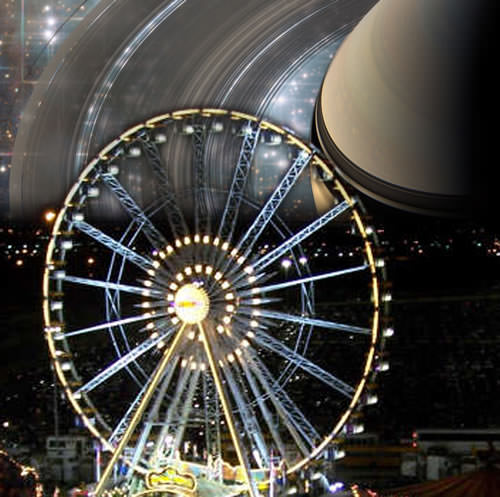Talk about a light show! A massive bolide was captured on video during a middle-of-the-night rock concert in Argentina on April 21, 2013. The band, Los Tekis performed at an outdoor concert venue and in perfect timing, right after the band concluded a song, the person who shot the video panned out so that the sky was visible — just as the bolide lit up the sky.
Continue reading “Bright Meteor Rocks Argentina Rock Concert”
Incredible Astrophoto: Space Station Flies Over Stonehenge
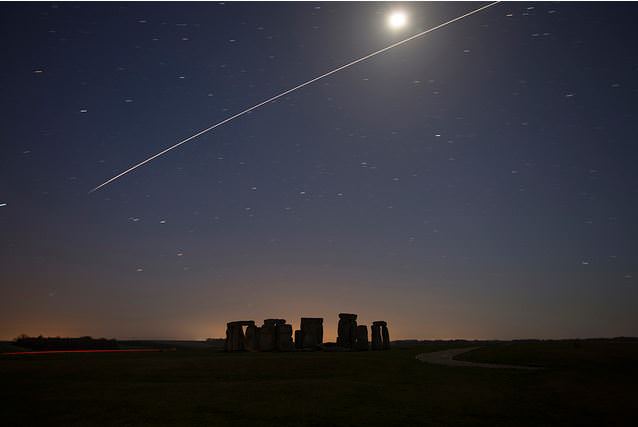
In a gorgeous mix of archeology and space exploration, photographer Tim Burgess captured a stunning view of the International Space Station passing over the historic and iconic Stonehenge on April 20, 2013. Tim said this composite image is composed of 11 shots, 10 sec, f2.8, 400 ISO. As one person commented on Flickr, “An amazing feat of human engineering passing over an amazing feat of human engineering, captured by an amazing feat of human engineering.”
Thanks to Tim for allowing us to post this image on UT; keep track of Tim’s photography on Flickr and Twitter.
Want to get your astrophoto featured on Universe Today? Join our Flickr group or send us your images by email (this means you’re giving us permission to post them). Please explain what’s in the picture, when you took it, the equipment you used, etc.
A ‘Shallow’ Lunar Eclipse Coming on April 25
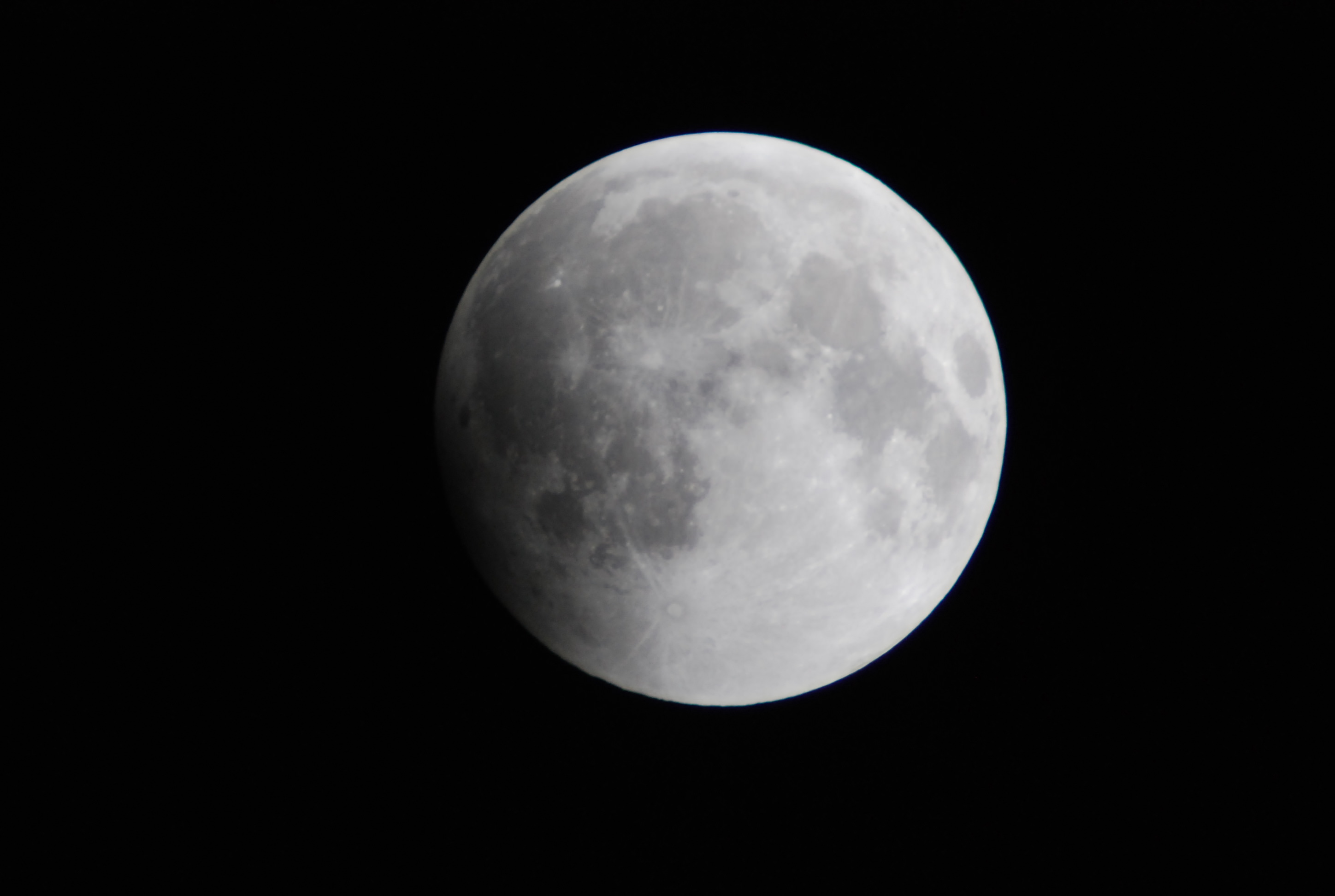
Eclipse season is upon us this week with the first eclipse of 2013, a brief partial lunar eclipse.
The lunar eclipse on April 25, 2013 is a shallow one, meaning only a paltry 1.47% of the lunar limb will be immersed in the dark umbra or inner shadow of the Earth. Observers can expect to see only a dark diffuse edge of the inner shadow nick the the Moon as is grazes the umbra.
A partial lunar eclipse this shallow hasn’t occurred since May 3rd, 1958 (0.9%) and won’t be topped until September 28th, 2034 (1.4%). This is the second slightest partial lunar eclipse for this century.
Another term for this sort of alignment is known as a syzygy, a great triple-letter word score in Scrabble!
A video simulation of the eclipse:
The eclipse will be visible in its entirety from eastern Europe & Africa across the Middle East eastward to southeast Asia and western Australia. The eclipse will be visible at moonrise from South America to Western Europe and occurring at moonset for eastern Australia and the Far East. The partially eclipsed Moon will be directly overhead just off the northeastern coast of Madagascar. The eclipse will not be visible from North America.
Two eclipse seasons occur each year when the nodal points of the Moon’s orbit intersect the ecliptic while aligned with the position of the Sun and the Earth’s shadow. The Moon’s orbit is inclined 5.15° degrees with respect to the ecliptic, which traces out our own planet’s path around the Sun. If this intersection occurs near New or Full Moon, a solar or lunar eclipse occurs.
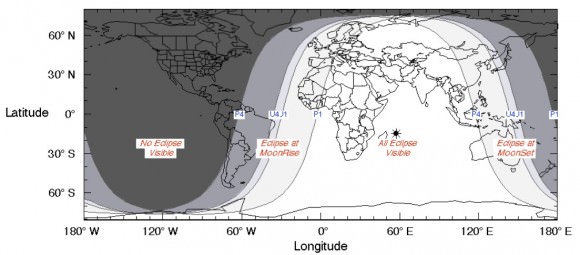
If the Moon’s orbit was not inclined to our own, we’d get two eclipses per lunation, one solar and one lunar.
2013 has 5 eclipses, 3 lunar and 2 annular. The minimum number of eclipses that can occur in a calendar year is 4, and the maximum is 7, as will next occur in 2038.
The 3 lunar eclipses in 2013 are this week’s partial eclipse on April 25th and two faint penumbral eclipses, one on May 25th and another on October 18th. There is no total lunar eclipse in 2013. The last one occurred on December 10th 2011, and the next one won’t occur until April 15th 2014, favoring the Pacific Rim region.
This eclipse will also set us up for the first solar eclipse of 2013, an annular eclipse crossing NE Australia (in fact crossing the path of last year’s total eclipse near Cairns) and the south Pacific on May 10th. The only solar totality that will touch the surface of the Earth in 2013 is the hybrid eclipse on November 3rd spanning Africa and the South Atlantic with a maximum totality of 1 minute & 40 seconds.
Contact times for the April 25 shallow eclipse:
P1-The Moon touches the penumbra-18:03:41 UT
U1-The Moon touches the umbra-19:54:04 UT
Mid-Eclipse-20:08:37.5 UT
U4 -The Moon quits the umbra-20:21:04 UT
P4-The Moon quits the penumbra- 22:11:23 UT
The length of the partial phase of the eclipse is exactly 27 minutes, and the length of the entire eclipse is 4 hours, 7 minutes and 42 seconds.
This particular eclipse is part of saros series 112 and is member 65 of 72.
This saros cycle began in 859 C.E. on May 20th and will end in 2139 on July 12th with a penumbral lunar eclipse. One famous member of this series was 52. This eclipse was one of many used by Captain James Cook to fix his longitude at sea on December 4th 1778. Christopher Columbus also attempted this feat while voyaging to the New World. It’s a fun project that anyone can try!
I also remember watching the last eclipse in this series from South Korea on April 15th 1995, a slightly better partial of 11.14%.
An occultation of the bright star Spica occurs just 20 hours prior as seen from South Africa across the southern Atlantic. This the 5th in a series of 13 occultations of the star by the Moon in 2013.
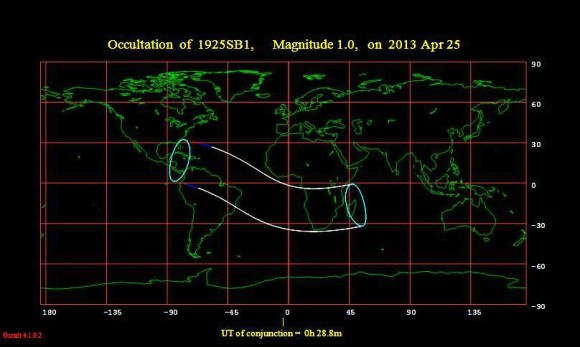
The +2.8th magnitude star Zubenelgenubi (Alpha Librae) is occulted by the waning gibbous Moon just 15 hours after the eclipse for Australia and the South Pacific.
Another occultation of a bright star with potential this week is +4.7th magnitude Chi Virginis across North America on the morning of Wednesday, April 24th centered on 4:24 UT.
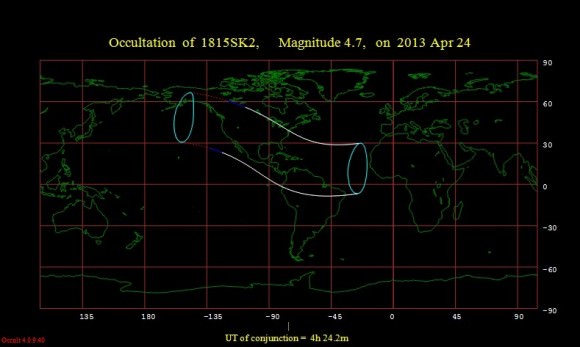
Also keep an eye out for +0.1 magnitude Saturn near the Full Moon. Saturn reaches opposition this weekend for 2013 on April 28th
Full Moon occurs near mid-eclipse at 20:00 UT/16:00 EDT on April 25th. Colloquial names for the April Full Moon are the Pink, Fish, Sprouting Grass, Egg, Seed, & Waking Moon.
Sure, the penumbral phases of an eclipse are subtle and may not be noticeable to the naked eye… but it is possible to see the difference photographically. Simply take a photo of the Moon before it enters the Earth’s penumbra, then take one during the penumbral phase and then another one after. Be sure to keep the ISO/f-stop and shutter speed exactly the same throughout. Also, this project only works if the eclipsed Moon is high in the sky throughout the exposures, as the thick air low to the horizon will discolor the Moon as well. Compare the shots; do you see a difference?
A penumbral eclipse would offer a good proof of concept test for hunting for transiting exoplanets as well, although to our knowledge, no one has ever attempted this.
Finally, calling out to all Universe Today readers in Madagascar. YOU may just be able to catch a transit of the International Space Station in front of the Moon just as the ragged edge of the umbra becomes apparent on the limb of the Moon. Check CALSky a day or so prior to the eclipse for a refined path… it would be an unforgettable pic!
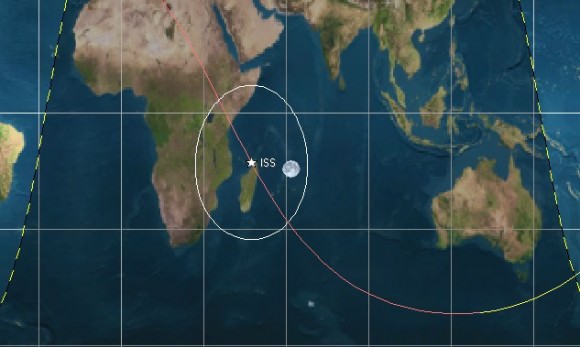
And if any ambitious observer is planning to live stream the eclipse, let us know and we’ll add your embed to this post. We do not expect an avalanche of web broadcasts, but hey, we’d definitely honor the effort! Slooh is usually a pretty dependable site for live eclipse broadcasts, and as of this writing seems to have broadcast scheduled in the cue.
Happy eclipse-spotting!
Historic Comet Smashup Brought Water to Jupiter’s Stratosphere
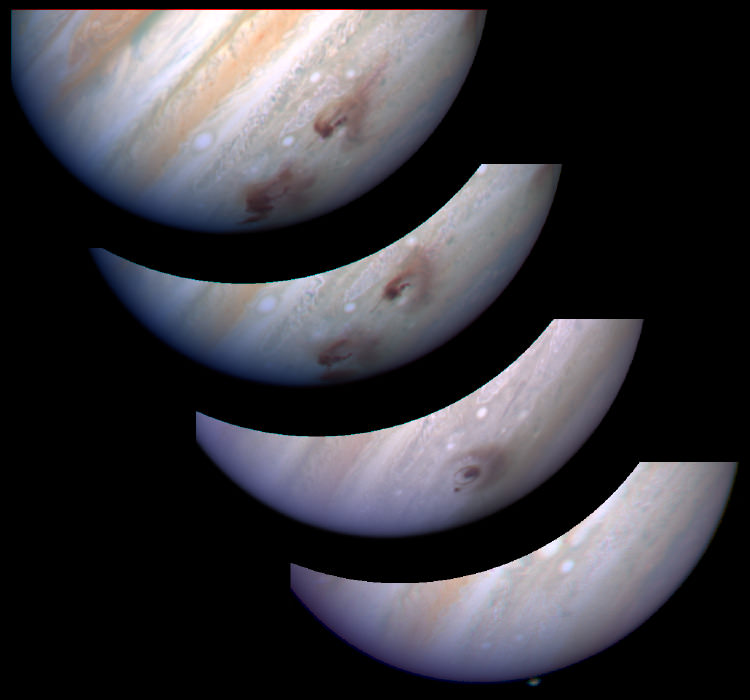
A large comet that peppered Jupiter two decades ago brought water into the giant planet’s atmosphere, according to new research from the Herschel space observatory.
Shoemaker-Levy 9 astounded astronomers worldwide when its 21 fragments hit Jupiter in June 1994. The event was predicted and observatories were trained on Jupiter as the impact occurred. The dark splotches the comet left behind were even visible in small telescopes. But apparently, those weren’t the only effects of the collision.
Herschel’s infrared camera revealed there is two to three times more water in the southern hemisphere of the planet, where the comet slammed into the atmosphere, than in the northern hemisphere. Further, the water is concentrated in high altitudes, around the various sites where Shoemaker-Levy 9 left its mark.
It is possible, researchers acknowledged, that water could have come from interplanetary dust striking Jupiter, almost like a “steady rain.” If this were the case, however, scientists expect the water would be evenly distributed and also would have filtered to lower altitudes. Jupiter’s icy moons were also in the wrong locations, researchers said, to have sent water towards the massive planet.
Internal water rising up was ruled out because it cannot penetrate the “cold trap” between Jupiter’s stratosphere and cloud deck, the researchers added.
“According to our models, as much as 95 percent of the water in the stratosphere is due to the comet impact,” said Thibault Cavalié of the Astrophysical Laboratory of Bordeaux, in France, who led the research.

While researchers have suspected for years that Jupiter’s water came from the comet — ESA’s Infrared Space Observatory saw the water there years ago — these new observations provide more direct evidence of Shoemaker-Levy 9’s effect. The results were published in Astronomy and Astrophysics.
Herschel’s find provides more fodder for two missions that are scheduled for Jupiter observations in the coming few years. The first goal for NASA’s Juno spacecraft, which is en route and will arrive in 2016, is to figure out how much water is in Jupiter’s atmosphere.
Additionally, ESA’s Jupiter Icy moons Explorer (JUICE) mission is expected to launch in 2022. “It will map the distribution of Jupiter’s atmospheric ingredients in even greater detail,” ESA stated.
While ESA did not link the finding to how water came to be on Earth, some researchers believe that it was comets that delivered the liquid on to our planet early in Earth’s history. Others, however, say that it was outgassing from volcanic rocks that added water to the surface.
Conventional theory dictates ice was in our solar system from when it was formed, and today we know that many planets have water in some form. Last year, for example, water ice and organics were spotted at Mercury’s north pole.
Mars appeared to be full of water in the ancient past, as evidenced by a huge, underground trench recently discovered by scientists. There is frozen water at the Martian poles, and both the Curiosity and Spirit/Opportunity rover missions have found evidence of flowing water on the surface in the past.
The outer solar system also has its share of water, including in all four giant planets (Jupiter, Saturn, Uranus and Neptune) and (in ice form) on various moons. Even some exoplanets have water vapor in their atmospheres.
“All four giant planets in the outer solar system have water in their atmospheres, but there may be four different scenarios for how they got it,” added Cavalié. “For Jupiter, it is clear that Shoemaker-Levy 9 is by far the dominant source, even if other external sources may contribute also.”
Source: European Space Agency
SpaceX Grasshopper Flies High
SpaceX’s Grasshopper flew 250 meters (820 feet) straight up, tripling the height flown on its previous leap. The video provides a great overhead view from SpaceX’s hexacopter.
Via Twitter, SpaceX CEO Elon Musk said the Grasshopper was able to remain steady in its flight even on a windy day, hover and then land.
Continue reading “SpaceX Grasshopper Flies High”
Carnival of Space #298
This week’s Carnival of Space is hosted by Pamela Hoffman at the Everyday Spacer blog.
Click here to read Carnival of Space #298.
And if you’re interested in looking back, here’s an archive to all the past Carnivals of Space. If you’ve got a space-related blog, you should really join the carnival. Just email an entry to [email protected], and the next host will link to it. It will help get awareness out there about your writing, help you meet others in the space community – and community is what blogging is all about. And if you really want to help out, sign up to be a host. Send an email to the above address.
3 Years of the Sun in 3 Minutes
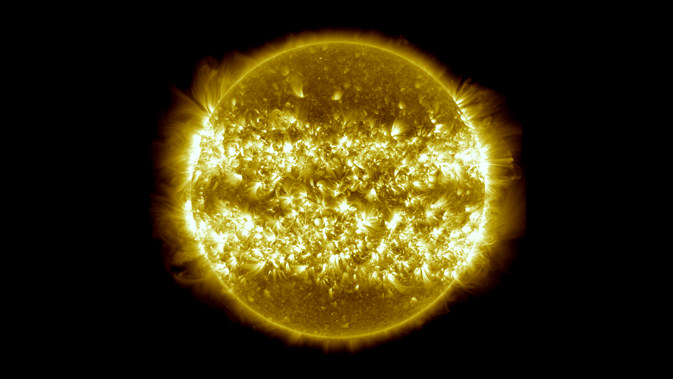
Since the Solar Dynamics Observatory opened its multi-spectral eyes in space about three years ago, we’ve posted numerous videos and images from the mission, showing incredible views of our dynamic Sun. Scott Wiessinger from Goddard Space Flight Center’s Space Visualization Studio has put together great timelapse compilation of images from the past three years, as well as a one composite still image to “try to encapsulate a timelapse into one static graphic,” he told us via email. “I blended 25 stills from over the last year, and it’s interesting to see the bright bands of active regions.” Scott said he was fascinated by seeing the views of the Sun over a long range of time.
Within the video, (below) there are some great Easter egg hunts – things to see like partial eclipses, flares, comet Lovejoy, and the transit of Venus.
How many can you find?
SDO’s Atmospheric Imaging Assembly (AIA) captures a shot of the sun every 12 seconds in 10 different wavelengths, but the images shown here are based on a wavelength of 171 Angstroms, which is in the extreme ultraviolet range. It shows solar material at around 600,000 Kelvin. In this wavelength it is easy to see the Sun’s 25-day rotation as well as how solar activity has increased over three years as the Sun’s solar cycle has ramped up towards the peak of activity in its 11-year cycle.
You’ll also notice that during the course of the video, the Sun subtly increases and decreases in apparent size. This is because the distance between the SDO spacecraft and the Sun varies over time. The image is, however, remarkably consistent and stable despite the fact that SDO orbits the Earth at 6,876 miles per hour and the Earth orbits the sun at 67,062 miles per hour.
See more views, wavelengths and information at this page at the Space Visualization Studio website.
Chris Hadfield Explains Photography from Space

After Canadian astronaut Chris Hadfield arrived at the International Space Station in December 2012, he quickly became an internet sensation with all the tweets, Facebook and G+ posts he shared providing in inside look at living and working in space. But the biggest draw is all the incredible images he has shared throughout his ISS mission. In this video, Hadfield takes you to the best seat in the house – the Cupola on the ISS — to gaze at the visual splendor of the Earth. He shares his techniques and his passion for capturing the fleeting glimpses of our changing world.
UPDATE: NASA also chimed in for Earth Day with this video from astronaut Don Pettit sharing his images and tips for photography of Earth from space:
Defiance: What Happens After Aliens Arrive
Wreckage, war and wrath are often the only results we see after aliens invade Earth, at least if you believe science fiction classics such as War of the Worlds. The new SyFy show Defiance, though, shows something a bit different: humans and aliens (Votans) trying to live side by side after the war.
Warning: minor spoilers ahead …
Now, this is no District 9. In 2046, the Votans roam around about as freely as the humans, although there’s a bit of ugly backstory that includes fighting and an uneasy truce. And no, this isn’t like Star Trek or Star Wars: the Votans and humans don’t work all that well together, at least not yet. Perhaps it’s too early in their history to think about it.
The show debuted on SyFy this month. Starring is Grant Bowler, previously of True Blood and Ugly Betty, as well as Dexter‘s Julie Benz.
“Nolan is an extreme pragmatist. He’s gone from war hero to scavenger and back again. He’s kind of the blunt instrument, if you like,” said Bowler of his human character in an NBC interview. Making things more interesting, Nolan has an alien adopted daughter and yes, they do actually get along (as well as most families do, anyway.)
When you have an hour on your hands, this one-hour discussion below about the show is well worth the watch. Don’t miss the part where Bowler talks about the challenge of working with “green screens”, which are essentially blank areas on set that are later filled with computer-generated graphics. Kind of disconcerting for an actor used to working on pre-arranged sets.
What other TV shows or movies featuring aliens can you recall that shows them living with humans after they get to Earth? Share them in the comments.
The Curious History of the Lyrid Meteor Shower
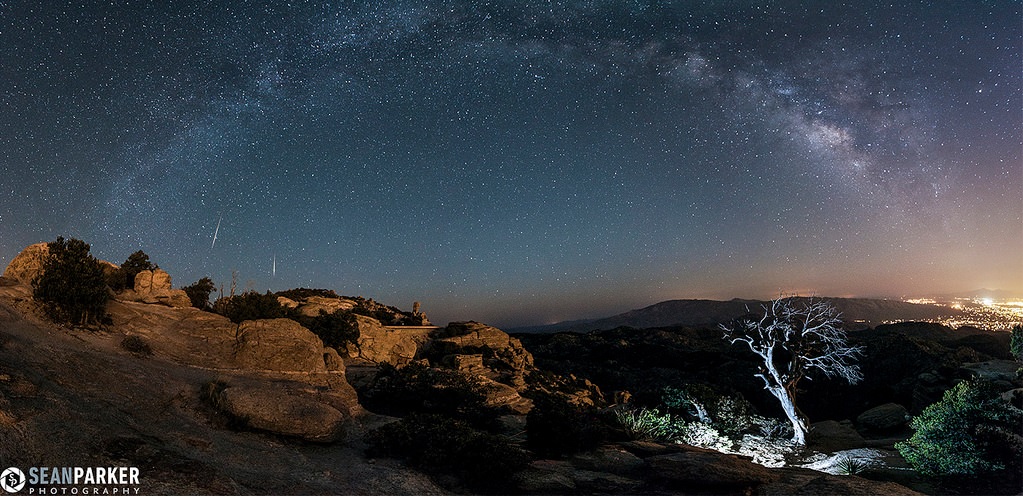
Today we residents of planet Earth meet up with a meteor stream with a strange and bizarre past.
The Lyrid meteors occur annually right around April 21st to the 23rd. A moderate meteor shower, observers in the northern hemisphere can expect to see about 20 meteors in the early morning hours under optimal conditions. Such has been the case for recent years past, and this year’s presence of a waxing gibbous Moon has lowered prospects for this April shower considerably in 2013.
But this has not always been the case with this meteor stream. In fact, we have records of the Lyrids stretching back over the past 2,600 years, farther back than any other meteor shower documented.
The earliest account of this shower comes from a record made by Chinese astronomers in 687 BC, stating that “at midnight, stars dropped down like rain.” Keep in mind that this now famous assertion that is generally attributed to the Lyrids was made by mathematician Johann Gottfried Galle in 1867. It was Galle along with Edmond Weiss who noticed the link between the Lyrids and Comet C/1861 G1 Thatcher discovered six years earlier.
Comet Thatcher was discovered on April 5th, 15 days before it reached perihelion about a third of an astronomical unit (A.U.) from the Earth. Comet Thatcher a periodic comet on a 415 year long orbital period.
But in the early to mid-19th century, the very idea that meteor showers were linked to comets or even non-atmospheric phenomena was still hotly contested.
One singular event more than any other triggered this realization. The Leonid meteor storm of 1833 in the early morning hours of November 13th was a stunning and terrifying spectacle for residents of the U.S eastern seaboard. This shower produces mighty outbursts, often topping a Zenithal Hourly Rate (ZHR) of over a 1,000 once every 33 to 34 years. I witnessed a fine outburst of the Leonids from Kuwait in 1998, and we may be in for a repeat performance from this shower around 2032 or 2033.
There is substantial evidence that the Lyrids may also do the same at an undetermined interval. On April 20th 1803, one of the most famous accounts of a “Lyrid meteor storm” was observed up and down the United States east coast. For example, one letter to the Virginia Gazette states;
“From one until three, those starry meteors seemed to fall from every point in the sky heavens, in such numbers as to resemble a shower of sky rockets.”
Another account published in the Raleigh, North Carolina Register states that:
“The whole hemisphere as far as the extension of the horizon seemed illuminated; the meteors kept no particular direction but appeared to move in every way.”
A study of the 1803 Lyrid outburst by W.J. Fisher cites over a dozen accounts of the event and is a fascinating read. Viewers were also primed for the event by the dramatic Leonid storm of 1799 four years earlier.
Interestingly, the Moon was only one day from New phase on the night of the 1803 Lyrids. Prime meteor watching conditions.
An unrelated meteorite fall would also occur four years later over Weston, Connecticut on December 14th, 1807 as recounted by Kathryn Prince in A Professor, A President, and a Meteor. These events would place Yankee politics at odds with the origin of meteors and rocks from the sky.
An apocryphal quote is often attributed to President Thomas Jefferson that highlights the controversy of the day, saying that “I would more easily believe that two Yankee professors would lie than that stones would fall from heaven.”
While both are of cosmogenous origin, no meteorite fall has ever been linked to a meteor shower, which is spawned by dust debris from comets. For example, many in the media erroneously speculated that the Sutter’s Mill meteorite that fell to Earth on the morning of April 22nd, 2012 was in fact a Lyrid meteor.
But a Lyrid may be implicated in another unusual 19th century observation. On April 24th 1874, a professor Scharfarik of Prague, Czechoslovakia was observing the daytime First Quarter Moon with his 4” refractor. The good professor was surprised by an “Apparition on the disc of the Moon of a dazzling white star,” which was “quite sharp and without a perceptible diameter.” Possible suspects are a telescopic meteor moving towards or along the observers’ line of sight or perhaps a Lyrid impacting the dark limb of the Moon.
Moving into the 20th century, rates for the Lyrids have stayed in the ZHR=20 range, with notable peaks of 100+ per hour noted by Japanese observers in 1922 and 100 per hour noted by U.S. observers in 1982.
It should also be noted that another less understood shower radiates from the constellation Lyra in mid-June. First noted Stan Dvorak while hiking in the San Bernardino Mountains in 1966, the June Lyrids produce about 8-10 meteors per hour from June 10 to the 21st. The source of this newly discovered shower is thought to be Comet C/1915 C1 Mellish.
A June Lyrid may have even made its way into modern fiction. As recounted in a July 2004 issue of Sky & Telescope, researchers Marilynn & Donald Olson note the following line from James Joyce’s Ulysses:
“A star, precipitated with great apparent velocity across the firmament from Vega in the Lyre above the zenith.”
Joyce seems to be describing a June Lyrid decades before the shower was officially recognized. The constellation Lyra rides high in the early morning sky for mid-northern latitudes in the early summer months.
All interesting concepts to ponder as we keep an early morning vigil for the Lyrids this week. Could there be more Lyrid storms in the far off future, as Comet Thatcher reaches perihelion once again in the late 23rd century? Could more historical clues of the untold history of this and other showers be awaiting discovery?
Somewhat closer to us in time and space, Paul Wiegert of the University of Ontario has also recently speculated that Comet 2012 S1 ISON may provoke a meteor shower on January 12th, 2014. Regardless of whether ISON turns out to be the “Comet of the Century,” this could be one to watch out for!

